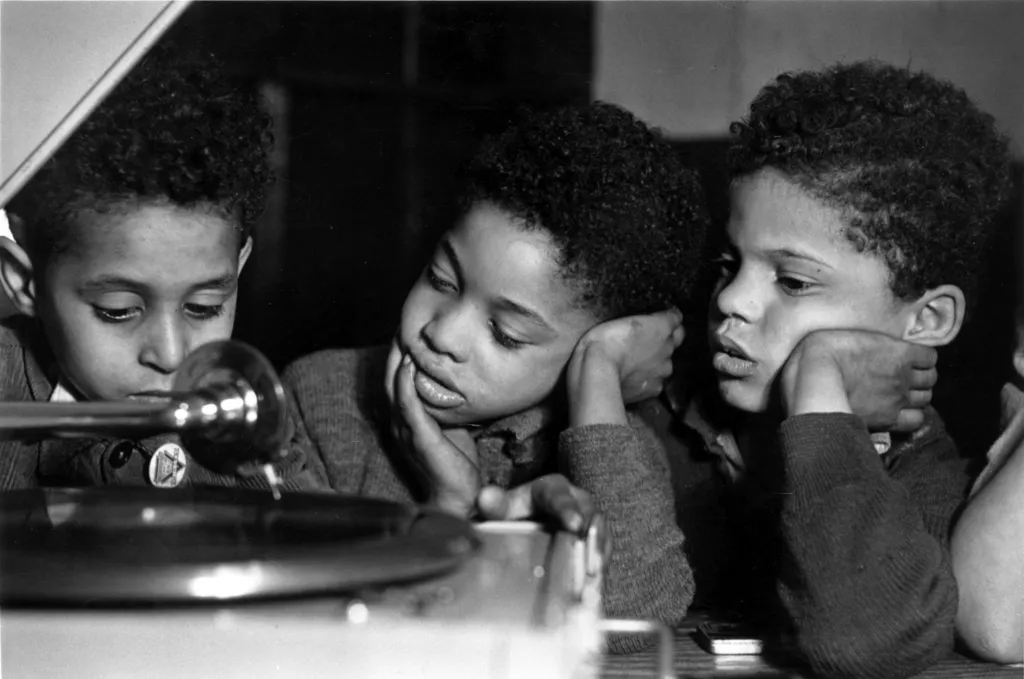"It wasn't whether we were black or white, Christian or Muslim or Greek Orthodox – if you lived in Tiger Bay, you were from the bay."
Gaynor Legall and three of her life-long friends have been looking at old photographs and reminiscing about growing up in Cardiff's Tiger Bay in the 1950s.
Tiger Bay is Wales' oldest multi-ethnic community and sprang up in the 1800s when sailors from around the world came to work around the city's prosperous coal trade.
Gaynor and her friends Dawn Collins, Pauline Williams and Farida Mohamed are all granddaughters of men who travelled from their homelands and grew up in the close-knit dockland community together.
"We never looked at people's colour, we never looked at people's race, we were one big happy family," recalled Pauline, 81.
The friends have been selecting photographs of old Tiger Bay to be displayed at National Museum Cardiff.
The black and white photos, taken by photographer Bert Hardy in 1950 for British Picture Post, will be shown at an exhibition about the photo-magazine.
The publication, which ran in the UK between 1938 and 1957, captured everyday life and major events and reached 1.7 million readers at its peak.
Seeing the images "just threw us back to childhood," said Farida, 81.
Dawn, 78, said it had made her look at her childhood in a new light.
"We thought that everything looked beautiful but when you look at some of the pictures you think they are kind of sad," she said.
"We looked poor, even though we didn't feel poor because everybody was in the same situation around us."
The women recalled a community where everyone looked out for each other.
"If Pauline's mother didn't have something she could knock my nana's door and vice versa," said Dawn.
"And you know what, you were glad to help, you always had somebody that you could turn to or just have a kind word."
The friends all grew up taking part in each other's religious and cultural events.
Dawn said at Eid all the children, regardless of religion, would go to the mosque wearing a headscarf and be fed.
"We were taught to respect from when we were little children," she said.
"We didn't feel threatened by other religions and other customs," added Gaynor.
"We embraced them, we took them… we just got involved in whatever our friends were doing and we were never turned away and made to feel different."
Tiger Bay was also a sanctuary from the racism the community experienced in various aspects of daily life.
In the 1950s and '60s it was not unusual for rental listings to include signs that read: "No blacks, no Irish, no dogs."
Black workers also often got paid less for the same work as their white counterparts.
"My father worked as a welder for a big steel company and used to train the white supervisors that would come in for them to be his supervisor," said Dawn.
"He would say at the table 'I trained another one today'."
Pauline recalled being refused entry to clubs because of the colour of her skin.
"Some of them would allow black women in because we are exotic and beautiful and so we would attract business," added Gaynor.
"But they wouldn't let the men and boys in."
She said there was a sense of "us against the rest of the world".
The railway bridge acted as a buffer between their community and the rest of Cardiff, they said.
"My father was chased home many, many, many times from different places and the minute he got under the bridge he could breathe a sigh of relief because the ones that were chasing him wouldn't come any further than that," said Dawn.
"We were clearly not welcome in town," added Gaynor.
"So the bridge was the sort of a barrier between us and them and there certainly was an us and them."
